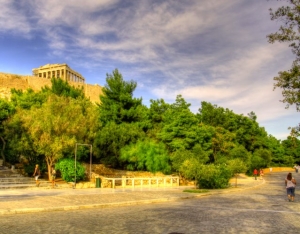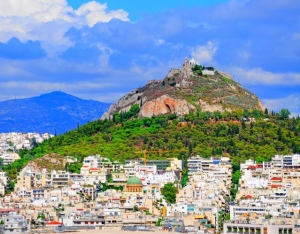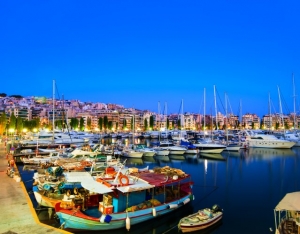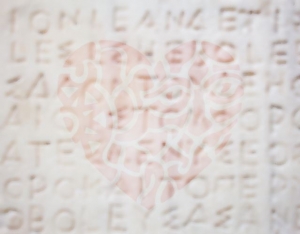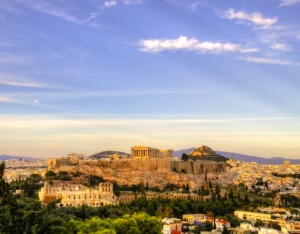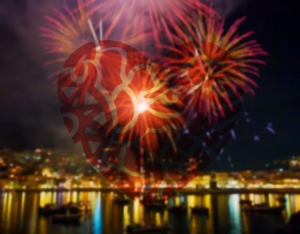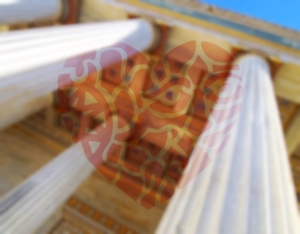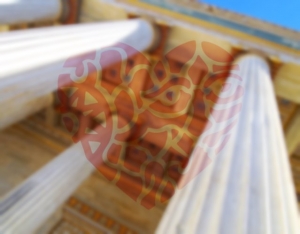Thodoris Bgenopoulos
The area of Athens around the Acropolis is probably the richest in sights per square meter in the world. We therefore need to see as much as possible...
Starting outside the Panathenaic Stadium, we take the Vasilisis Olgas street towards Acropolis. On our left is the Temple of Olympian Zeus and on our right the Zappeion. At the end of the road we turn left to admire the Hadrian's Gate and then pass right across. One of the most beautiful pedestrian streets of Europe, Dionysiou Areopagitou Street, starts from here. It is located just below the Acropolis, giving you the feeling of another era. As you walk by, you will notice that wherever you look, there are unique attractions. On our right there is the theater of Dionysus, on our left there is the New Acropolis Museum, with its unique exhibits and just above us lies the renowned Acropolis. If you follow the (several) steps that take you to the sacred hill, you will see the Propylaea, the Temple of Athena Nike, the Erechtheion and of course the Parthenon; all lasting through the years, calling for your gaze. Enjoy the spectacular view from the top, but take care to return soon because there are still a lot of things to see. After passing through the Odeon of Herod Atticus, you have to turn right to another beautiful pedestrian street known as Apostolou Pavlou. Here we are literary drenched in attractions: the Ancient Agora with the Stoa of Attalos, the hills of Areos Pagos, Pnyx (Pnika) and Philopappos, the famous Thisseio and the Temple of Hephaestus that gave his name to the region. Of course, you are also expected to find here several shops and restaurants or cafes and bars that offer a stunning view of the Acropolis. Apostolou Pavlou street ends in Kerameikos and Gazi, while on the right there is Plaka, Monastiraki and Psiri.
No one in his right mind would visit Athens, the capital of Greece and forget to stroll around its center.
We start from Syntagma Square, which is perhaps the most typical meeting place for Athenians visitors. Here you can admire the Palace of the Greek Parliament and the Tomb of the Unknown Soldier, while beside it you will find the National Garden, awaiting for you to explore it. Following on, there is Panepistimiou street, which actually means the street of the university and although it is a commercial district, it mostly stands out for its unique buildings. First of all there is the Ilion Melathron that houses the Numismatic Museum, and afterwards we see the famous Athenian Trilogy; three classic buildings, one more beautiful than the other: the Academy, the University and the National Library. Continuing on, we reach the second most central square in Athens, Omonia Square. This is the starting point for several main roads of Athens, but we will follow Stadiou street. Going upwards in Stadiou street, we pass by Klafthmonos Square and the Museum of the City of Athens, facing the building the Old Parliament. Here is also the National History Museum. Stadiou Street ends at Syntagma Square, right where we started. Now lets take another road, the Vasilisis Sofias Avenue. Going upwards in Vasilisis Sofias Avenue, we will see the outstanding museums of Athens, left the Benaki Museum and the Museum of Cycladic Art, and right the Byzantine&Christian Museum and the War Museum. Continuing straight on Vasilisis Sofias Avenue, there is the impressive Hilton Hotel and the National Gallery right next to it. Yet, we will turn left to have a walk in Kolonaki.
Built at the foot of Lycabettus Hill, Kolonaki is the old aristocratic neighborhood of Athens. Its exceptional shopping area has always been a hot-spot for wealthy Athenians and visitors, while Kolonaki Square is a must for a quick coffee before you continue your wandering in the capital.
Piraeus is the main port of Athens and the most significant in Greece and the Eastern Mediterranean. It is a starting point for ships to most islands of Greece and an important destination for many cruise ships.
Since ancient times the Athenians gave great importance to the port of Piraeus, which was the base of their naval forces. They had catered greatly to fortify it with walls, parts of which still stand today.
Piraeus port also had other names, including the famous "Porto Leone", owing to the marble lion that used to be at the port's entrance. Today in this very spot you will find a duplicate, since the original was stolen by Morosini and moved to Venice.
Once in Piraeus, during the day you can visit the Archaeological Museum of Piraeus and the Maritime Museum, stroll around the docks and the port or simply gaze at the vessels. If you get hungry, there are a lot of restaurants and taverns with fresh fish, seafood or anything else you may desire. Otherwise, if you are not hungry (or right after you eat) you can have your coffee in one of the several cafes by the sea and enjoy the spectacular view.
All that during the day, because once night falls, Piraeus becomes the center of entertainment. With Mikrolimano as focal point, fantastic clubs by the sea and great bars give you a sense of Greek nightlife.
South from the city center and along the beach, are the areas of Faliro, Alimos, Glyfada, Voula and Vouliagmeni, ideal destination for a walk by the sea.
Starting from Faliro, there is a beautiful beach park, where you can take a walk on foot or bike and chill, enjoying your coffee, food or drink. Nearby is the Maritime Tradition Museum , with the Averof battleship that is definitely worth your attention. Moving to the south and passing thourgh Alimos, we reach Glyfada. This is a suburb with an enormous shopping area and the only golf course in Athens, for those who love this cosmopolitan sport. Continuing south there is Voula and then we end up in Vouliagmeni, which is said to be one of the most beautiful suburbs in Athens. Here also lies the famous Vouliagmeni lake, popular for its thermal waters. Continuing on the coastal road ( Athens-Sounion Avenue), you will stumble upon a series of excellent beaches, where you can opt for a swim, before we reach the southernmost tip of Attica; Sounion and the Temple of Poseidon.
Inevitably at some point you will get hungry and the Southern suburbs have the solution. Excellent restaurants ranging from luxury and gourmet, to family-run taverns, with flavors from Greek and international cuisine, along with cafes and snack-bars, are here to cater for you. Adding to that, imagine a perfect night-out by the sea. For the Athenians who live in the south, this is not a dream but a tangible reality that takes place once night falls. The fantastic beach clubs overlooking the sea and the special bars, offer you the chance to experience the Greek meaning of nightlife during your vacations.
If you go north from the central Athens you will find the areas of Psychico, Filothei, Marousi, Kifisia, Ekali, but also Chalandri, Melisia, Vrilisia, Pefki, Nea Erythrea and Agia Paraskevi.
The Northern suburbs were originally (and still are) mainly residential areas of the more affluent residents of Athens. They are characteristically green and quiet (compared to the hustle and bustle of the center of Athens). Filothei and Psihiko are areas where no big stores are authorized, whereas in Kifissia and Maroussi you have the opportunity to discover a wonderful shopping area with impressive shopping malls and stores. In Maroussi you will also find the OAKA athletic infrastructures that hosted a big part of the Olympic Games in 20004 and the opening-closing ceremonies.
If you stroll around Kifissia, you will admire magnificent mansions, many of which date back even to 19the century and are reminiscent of another era. Moreover, there you can visit the excellent Goulandris Museum of Natural History.
If you find yourself hungry somewhere in the Northern suburbs, you are lucky. There are several cozy cafes and snack-bars, as well as exquisite dinning-options, ranging from luxury and gourmet restaurants to family-run taverns, with flavors from Greek and international cuisine. And when the night falls, fantastic clubs and bars of unique character let you in the greek meaning of nightlife. I bet your warm bed will not even cross your mind...
According to mythology, there was a contest between goddess Athena and god Poseidon so as to elect the city's patron. The goddess won, thus giving her name to Athens and taking responsibility of the city's protection. The Parthenon is considered to be a dedication to Athena and this is why it hosts her statue.
There have been claims of Athens being inhabited already by 9,000 BC However, it is not until the 6th century B.C. that it gains its prominent space in history. It is from then onwards that it starts to take gigantic proportions and a dominant position in Greece with its naval power. Thanks to this power it acquires great wealth, with which some of the most important buildings of the city were made,especially during the "Golden Age of Pericles". The Parthenon on the Acropolis is the culmination of all this great development.
Following its defeat in the Peloponnesian War and the famine that accompanied it, Athens lost much of its acquired power. During Roman times Athens was still an important cultural center. Yet, after the looting it suffered by Sulla in 86 BC and Heruli in 267 AD, much of its infrastructure was destroyed and its further development was hindered.
Years later, the Byzantine domination together with the Frankish and Ottoman rule, constituted Athens even more diminished in size and importance.
When the Greek Revolution breaks in 1821, Athens is a small and relatively insignificant town. The shift in its history occurs in 1833, when it is proclaimed as the Greek State's capital, succeeding Nafplion. This signifies its new rapid development,which shapes the city in the image we have today.
Countless books have been written and documentaries have been filmed about the history and the significance of Athens. Yet, nothing can compare to a visit to the city. Go for the real thing!
Athens is the capital and the largest city of Greece, covering most of the region of Attica. Over the years, the city of Athens expanded so much that gradually Athens-city and Attica-region became almost identical notions. The region of Attica is 3.808 square km. Even though it occupies only 3% of the Greek territory, it is the place where over 1/3 of the total population is concentrated.
Athens, thanks to its unique attractions (with the Acropolis being the most renown) and its excellent museums, is a top tourist destination. Every year millions of tourists from all over the world choose to spend their holidays in Athens, or have it as a stopover before going to another of the dozens of wonderful places in Greece.
The region of Attica and particularly Athens, has everything you would expect from a European capital. Great shopping area, welcoming hotels and quality restaurants with vast variety. You will literally be at a loss: cool bars, clubs and cafes, theaters and cinemas, the famous Greek bouzoukia and several other entertainment proposals await for you.
Athens, just like any capital that respects itself, has an excellent transportation system, including Metro, trolleybuses, trams and buses. Unfortunately, traffic jams and the atmosphere they create cannot be avoided, but that's the price every big capital has to pay.
The city of Athens is in the basin of Attica, which is shaped by five mountains: Parnitha, Penteli, Hymettus, Mount Egaleo and Poikilo Mountain. The climate is temperate Mediterranean.
Athens is without doubt an ideal holiday destination.
Santorini, like every other place in Greece, maintains its own traditions and customs, which visitors have the chance to get to know through various events.
Easter in Santorini, as throughout Greece, is a once in a lifetime experience not to be missed. The procession of the Epitaph in the scenic alleys, the Resurrection of Christ with the following fireworks(and the volcano in the background) and of course the much-anticipated Eastern dinner, will undoubtedly remain deeply etched in the memory of every visitor.
Apart from Easter there are many festivals and celebrations, mainly religious, yet full of dancing, singing and feasting. Some of them are:
- 20th of July, Prophet Elias in Fira
- 6th of August, Metamorfosi tou Sotira
- 15th of August, Panagias Episkopis in Kamari and other parts of the island
- 20th of October, Agias Matronas in Foinikia
- 22nd of October, Agiou Averkiou wine feast in Eborio
- 6th of December, Agios Nikolaos day
As well as the Kamariano Thalassino Panigiri (Sea fest) in Kamari, during August.
For more information contact the Cultural Organization of Santorini (DAPPOS) in number 22860- 24828.
The Naval Museum of Oia is, of course, in Oia and was founded on the initiative of Antonis Dakoronias, one of the captains of Santorini. It is currently housed in a beautiful neoclassical building, donated by Dina Manolessou Birbili. In the museum, the visitor can be informed about the important naval history of the island, which flourished mainly between 1900 and 1940. Through manuscripts, photographs, calendars, model ships and other nautical items we learn the island's marine history.
More information about the Maritime Museum of Oia can be found in the number 22860-71156.
The Folklore Museum Lignos is just one km away from Fira, in Kontochori. It was founded by M. Lignos and built about half a century ago, it is situated in a cave. In the museum you can see a fully formed cave house, a canava (old winery) and many traditional workshops. The Lignos Folklore Museum also features historical records of the island of Santorini, while in its premises paintings of famous artists are exposed. What else could be the main theme, but Santorini...
More information about the Folklore Museum " Emm. A. Lignos " , can be found in www.santorinisfolkmuseum.com and the number 22860 22792.

